10 Vegetables Packed With Iron You’ve Probably Never Heard Of
Surprising Sources of Iron: Boost Your Health with These Unique Veggies

Vegetables with Iron (Table) | Dried Spirulina | Dried Agar Seaweed | Dried Chives | Raw Morel Mushrooms | Dried Ancho Peppers | Dried Red Sweet Peppers | Dried Pasilla Peppers | Sun-dried Tomatoes | Raw Irish moss Seaweed | Raw Lemongrass | Iron RDI | Heme vs Non-Heme | Other Veggies | Questions | Bottom Line
Did you know that some lesser-known vegetables have double and triple the iron content of the foods you often read about in online health articles?
For example, dried spirulina packs an impressive 28.5 mg of iron per 100 grams, while dried agar seaweed has 21.4 mg. Dried chives offer 20 mg, raw morel mushrooms contain 12 mg, and dried ancho peppers deliver 11 mg.
These veggies are not just rich in iron; they’re also full of essential vitamins and minerals. Adding them to your meals can greatly boost your iron intake. Ready to discover more nutrient-dense vegetables? There are plenty of surprises ahead!
Top 10 Vegetables With Iron
Here’s a table with iron content and RDA percentage for men aged 19-50 for each vegetable. The data come from the USDA National Nutrient Database and the U.S. Department of Health & Human Services, National Institutes of Health.
| Vegetable | Iron (per 100g) | Percentage of RDA |
|---|---|---|
| Dried Spirulina | 28.5 mg | 356% |
| Dried Agar Seaweed | 21.4 mg | 268% |
| Dried Chives | 20 mg | 250% |
| Raw Morel Mushrooms | 12 mg | 150% |
| Dried Ancho Peppers | 11 mg | 138% |
| Dried Red Sweet Peppers | 10.4 mg | 130% |
| Dried Pasilla Peppers | 9.83 mg | 123% |
| Sun-dried Tomatoes | 9.1 mg | 114% |
| Raw Irish moss Seaweed | 8.9 mg | 111% |
| Raw Lemongrass | 8.17 mg | 102% |
1. Dried Spirulina – 28.5mg

Dried spirulina, a type of blue-green algae, contains an impressive 28.5mg of iron per 100 grams. This is 356% of the recommended daily allowance for men aged 19-50. It’s a fantastic way to boost your iron intake without relying on meat.
You can find dried spirulina in a dark green powder or flakes. It’s easy to add to smoothies, juices, or water. You can also use it in cooking to add a nutritious boost to your meals.
Besides its high iron content, dried spirulina is packed with other essential nutrients. It has lots of Vitamin B1, B2, and B3, which are great for energy. It also contains Vitamins B5, B6, B9, E, and K, plus some Vitamin C.
In terms of minerals, spirulina has high levels of copper and manganese. It’s also a good source of magnesium, potassium, and sodium. Additionally, dried spirulina is rich in protein and omega-3 fatty acids.
This makes it a well-rounded dietary supplement with many health benefits.
2. Dried Agar Seaweed – 21.4mg
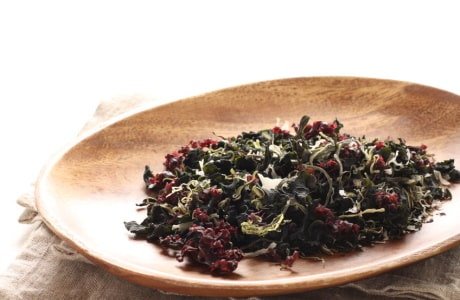
Agar seaweed is a fantastic source of iron, with 21.4mg per 100 grams. This amount is 268% of the daily recommended iron for men aged 19-50.
This dried seaweed is popular in Asian cuisine. It’s often used to thicken soups, stews, and desserts. To use dried agar seaweed, soak it in water to rehydrate it before cooking.
Agar seaweed isn’t just rich in iron; it also has a lot of other nutrients. It’s packed with vitamins and minerals like Vitamin B9, Magnesium, and Manganese. It’s also a great source of Vitamin B5, B6, E, and K, along with Calcium, Copper, Potassium, and Zinc.
Additionally, it has good amounts of Vitamin B2, Phosphorus, and Selenium. These nutrients make it a well-rounded addition to your diet.
3. Dried Chives – 20mg

With an impressive 20mg of iron per 100 grams, dried chives offer 250% of the daily recommended iron intake for men aged 19-50. These tiny, green flakes aren’t only a great source of iron but also a convenient way to add a mild onion flavor to your dishes.
Adding dried chives to your meals can boost your iron intake, which is essential for healthy red blood cells and preventing anemia.
Besides iron, dried chives are packed with essential vitamins and minerals. They provide lots of Vitamin A, B2, B6, and C. You’ll also find good levels of Vitamin B1, B3, B5, and B9, making them a well-rounded addition to your diet.
Their mineral content is equally impressive, with high levels of calcium, magnesium, and potassium, along with notable amounts of copper, manganese, phosphorus, and zinc.
For best results, store dried chives in a cool, dry place in an airtight container to maintain their flavor and nutrients. Add them to soups, salads, or use them as a garnish to enjoy both their taste and health benefits.
4. Raw Morel Mushrooms – 12mg
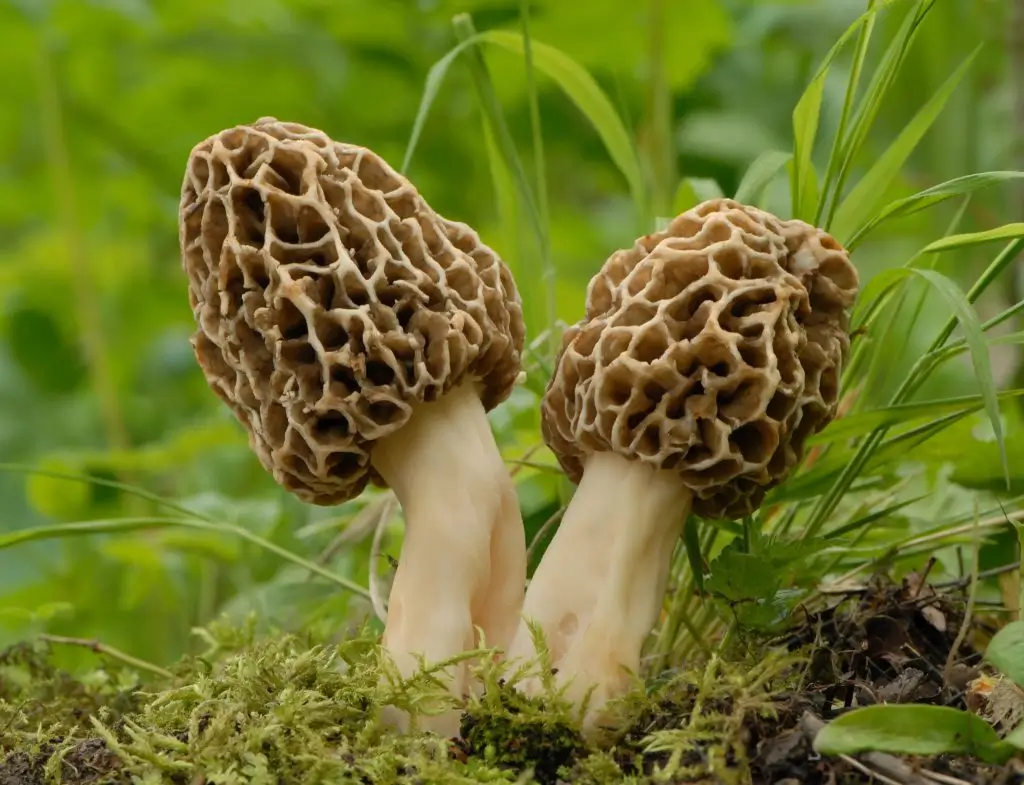
Raw Morel Mushrooms, providing 12mg of iron per 100 grams, deliver 150% of the daily recommended intake for men aged 19-50, making them a top choice for boosting iron levels. These unique fungi, with their honeycomb-like appearance and hollow stems, aren’t just visually striking but also packed with nutrients.
Morels are highly prized in the culinary world for their earthy, nutty flavor, making them a gourmet favorite. Typically found in forests near elm, ash, and oak trees, they usually appear in the spring after it rains and the ground warms up. This makes them a seasonal treat worth seeking out.
Besides their high iron content, raw morel mushrooms are a great source of Vitamin D, essential for bone health.
They also offer B vitamins—B2, B3, B5, and B6—that help with energy and overall health. They contain significant amounts of copper, manganese, and phosphorus, which are important for various body functions. The inclusion of potassium, zinc, and fiber further enriches their nutritional profile, supporting heart health and digestion.
⛔ It’s important to know that morel mushrooms can be poisonous if not properly identified and prepared. While true morels are generally considered safe to eat after proper cooking, they can contain varying levels of heat-labile toxins that can cause health problems if consumed raw. [1]
5. Dried Ancho Peppers – 11mg
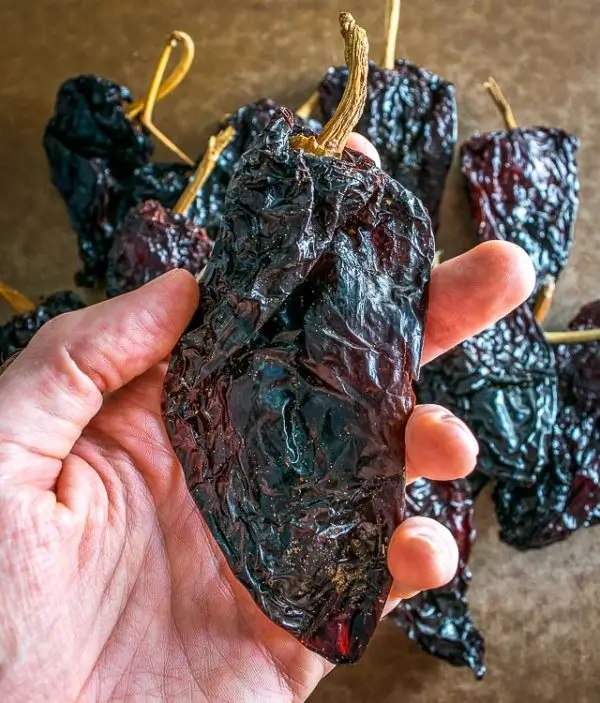
You might be surprised to learn that dried ancho peppers pack a significant punch with 11mg of iron per 100 grams, covering 138% of the daily recommended intake for men aged 19-50.
Ancho peppers, which are dried poblano peppers, are commonly used in Mexican cuisine. They offer a mild heat level, making them perfect for those who prefer less spicy foods. Their sweet and smoky flavor makes them great for sauces, salsas, marinades, and rubs.
Besides their high iron content, dried ancho peppers are very nutritious. They’ve lots of Vitamin A, Vitamin B2, and Vitamin B6, which are crucial for good health. They’re also a good source of Vitamins B3 and B5 and have decent amounts of Vitamins B1 and B9.
When it comes to minerals, dried ancho peppers are rich in copper, magnesium, manganese, phosphorus, and potassium, and they also provide a beneficial amount of zinc.
For those looking to improve their diet, these peppers offer good amounts of omega-6 fatty acids, carbohydrates, fiber, and protein.
Adding dried ancho peppers to your meals can be a tasty and effective way to boost your nutrient intake while enjoying their unique flavor.
6. Dried Red Sweet Peppers – 10.4mg

Dried red sweet peppers pack a powerful punch with 10.4mg of iron per 100 grams, giving men aged 19-50 about 130% of their daily iron needs.
The drying process concentrates their nutrients, turning these mild, sweet peppers into a nutrient-rich food.
Besides their iron content, dried red sweet peppers are full of essential vitamins and minerals. They’ve lots of Vitamin A, B1, B2, B6, C, and K. These vitamins help with good vision, energy production, immune function, and blood clotting. They’re also a great source of Vitamin B3, B9, and E, which support cell health and protect against damage.
In terms of minerals, dried red sweet peppers are rich in copper, manganese, and potassium. These minerals are important for enzyme activity and keeping fluid balance in the body. They also have significant amounts of magnesium, phosphorus, and zinc, which help with bone health and immune function.
Additionally, these peppers provide carbohydrates, sugars, fiber, protein, and healthy fats like Omega 3 and Omega 6, making them a well-rounded addition to a balanced diet.
7. Dried Pasilla Peppers – 9.83mg
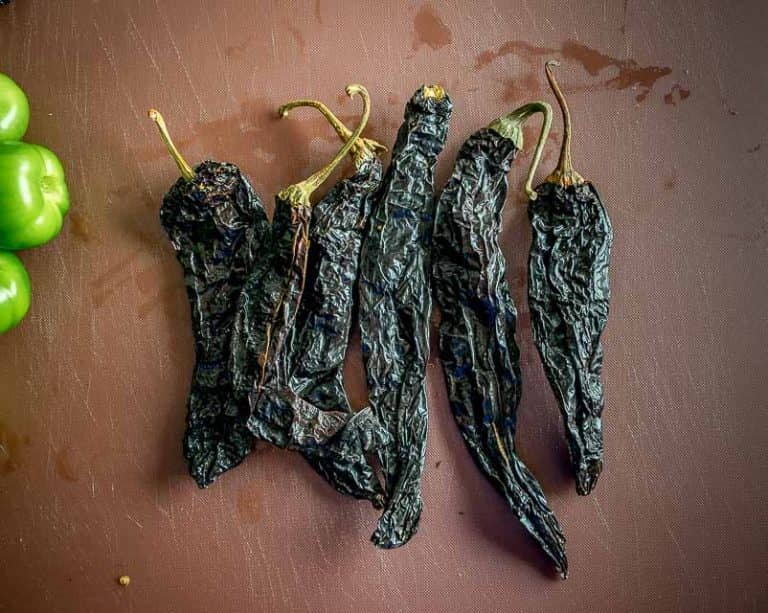
Dried pasilla peppers are also rich in iron, with 9.83mg per 100 grams. This amount covers 123% of the recommended daily intake for men aged 19-50.
Pasilla peppers are a key ingredient in Mexican cuisine. When fresh, they’re long and dark green, but they turn dark brown and wrinkled when dried. Their rich, smoky flavor and mild to medium heat make them versatile in many dishes.
You can use pasilla peppers in sauces, salsas, and stews to add unique flavor and a bit of heat. They’re also great for stuffing, roasting, or making chili powder. When using dried pasilla peppers, soak them in hot water to rehydrate. Removing the seeds and stems helps control the heat level.

Beyond iron, dried pasilla peppers are packed with other essential nutrients. They’ve significant amounts of Vitamins A, B2, and B6.
They’re also excellent sources of Vitamins B3, B5, and B9. Additionally, they provide important minerals like copper, magnesium, manganese, phosphorus, and potassium.
With their robust nutritional profile, adding dried pasilla peppers to your diet can greatly improve your overall nutrient intake.
8. Sun-dried Tomatoes – 9.1mg
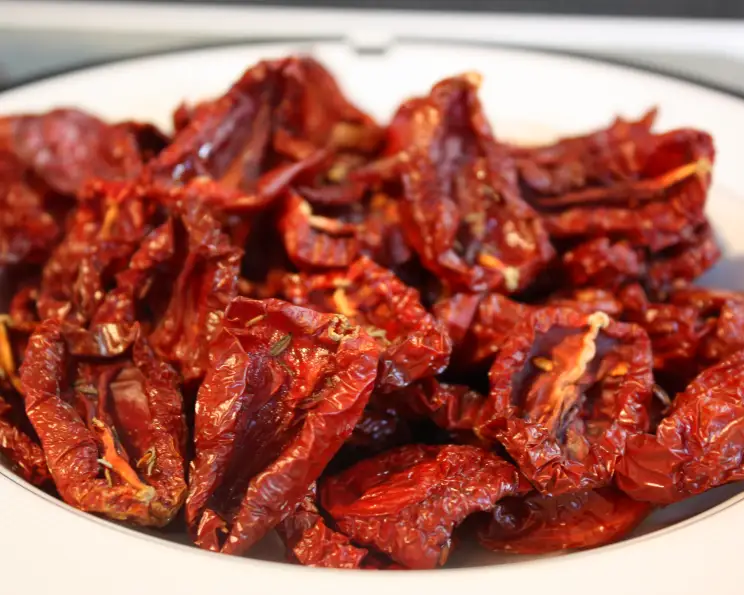
How can you boost your iron intake with a burst of flavor? Sun-dried tomatoes are an excellent choice. They pack 9.1mg of iron per 100 grams, meeting 114% of the recommended daily allowance for men aged 19-50. These nutrient-rich “gems” not only improve your iron levels but also add a unique, tangy-sweet taste to your meals.
Sun-dried tomatoes are ripe tomatoes that have been dried in the sun, concentrating their flavors and nutrients.
Besides their high iron content, they’re full of other essential vitamins and minerals. They offer a great source of Vitamin B1, B2, B3, B5, B6, Vitamin C, and Vitamin K. You’ll also find a good amount of Vitamin B9 in them.
When it comes to minerals, sun-dried tomatoes are rich in Copper, Manganese, and Potassium. They’ve excellent amounts of Magnesium and Phosphorus. They also contain good levels of Calcium, Selenium, Sodium, and Zinc. On top of that, they provide an outstanding source of carbohydrates, sugars, fiber, and protein.
Adding sun-dried tomatoes to your diet is easy. Toss them into salads, pasta, or sandwiches. Their rich nutrient profile can make a big difference to your overall health.
9. Raw Irish moss Seaweed – 8.9mg
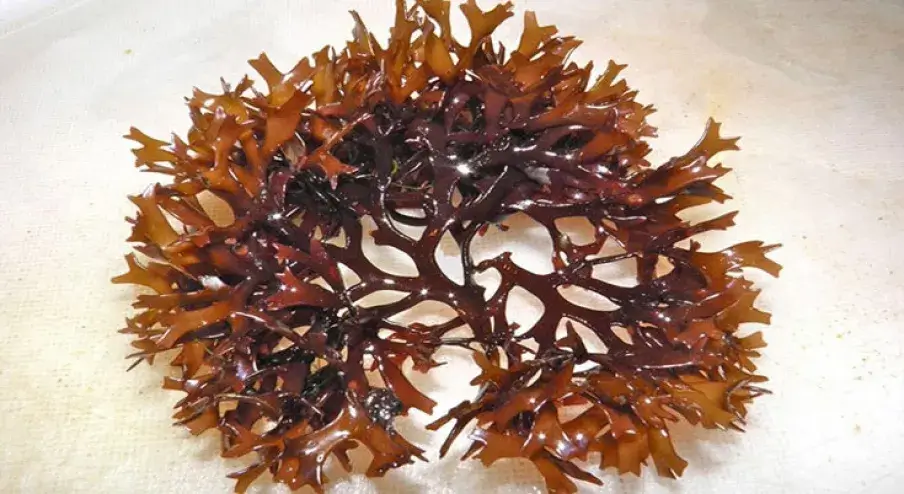
If you’re looking to boost your diet with an iron-rich vegetable, consider Raw Irishmoss Seaweed. It offers 8.9mg of iron per 100 grams, which is 111% of the recommended daily allowance for men aged 19-50. This red algae, known as Chondrus crispus, grows along the rocky Atlantic coasts of Europe and North America.
In its fresh state, it ranges in color from greenish-yellow to dark purple and has a soft, cartilaginous texture.
Adding Raw Irishmoss Seaweed to your diet can greatly increase your iron intake. Iron is essential for making hemoglobin and keeping your energy levels up. Besides iron, this seaweed is rich in Vitamin B2 (riboflavin) and Vitamin B9 (folate), which are crucial for metabolism and keeping your cells healthy.
It’s easy to include this seaweed in your meals. You can toss it into soups, blend it into smoothies, or mix it into salads for a nutritional boost. Its neutral flavor makes it a versatile ingredient that won’t overpower other tastes.
10. Raw Lemon Grass – 8.17mg

Raw lemon grass, with 8.17 mg of iron per 100 grams, gives 102% of the recommended daily allowance for men aged 19-50.
You can eat lemongrass raw, and it’s a popular ingredient in Thai salads like Yum Takrai, a spicy seafood salad with lemongrass and ginger. But be sure to remove the tough outer stem and slice it thinly, as raw lemongrass can be “tough”.
Besides its high iron content, 100 grams of raw lemongrass has other important nutrients. It’s a good source of Vitamin B2 (riboflavin) and Vitamin B9 (folate), which are essential for energy and cell function. It’s also rich in manganese, a mineral important for bone health and metabolism.
Raw lemongrass is also a great source of copper, potassium, and zinc. These minerals help with immune support and heart health.
Adding raw lemongrass to your diet not only enhances flavor but also provides valuable nutrients that support overall well-being.
What is the Recommended Daily Intake of Iron?
According to the National Institutes of Health, your daily iron needs depend on your age, sex, and diet. Vegetarians need almost twice as much iron because the body doesn’t absorb plant-based iron as well as animal-based iron.
- Birth to 6 months: 0.27 mg
- Infants 7–12 months: 11 mg
- Children 1–3 years: 7 mg
- Children 4–8 years: 10 mg
- Children 9–13 years: 8 mg
- Teen boys 14–18 years: 11 mg
- Teen girls 14–18 years: 15 mg
- Adult men 19–50 years: 8 mg
- Adult women 19–50 years: 18 mg
- Adults 51 years and older: 8 mg
- Pregnant teens: 27 mg
- Pregnant women: 27 mg
- Breastfeeding teens: 10 mg
- Breastfeeding women: 9 mg
Adult women aged 19-50 need 18 mg of iron daily, while men in the same age group need only 8 mg.
Pregnant women need much more, at 27 mg daily, due to increased blood volume and the needs of the fetus.
Teenage girls also need more iron (15 mg) compared to teenage boys (11 mg), mainly due to menstruation.
Heme iron Vs Non-heme iron
Heme iron, found in animal products like beef and chicken, is absorbed more efficiently by the body compared to non-heme iron from plant sources. If you’re a vegetarian or vegan, you might need to increase your iron intake because non-heme iron isn’t absorbed as easily.
Another important thing to know is that certain vegetables, like lentils and chickpeas, (who also have a lot of iron) contain high levels of phytates. Phytates can block iron absorption, as well as other minerals such as zinc, magnesium, and calcium. [1]
This makes it even more important for plant-based eaters to be mindful of their iron sources. However, you can improve non-heme iron absorption by pairing it with vitamin C-rich foods, such as oranges or bell peppers. For instance, research has shown that adding 63 mg of vitamin C to a meal rich in non-heme iron can boost iron absorption by nearly threefold.
KEY TAKEAWAY:
Try to incorporate vitamin C-rich foods like oranges, lemon juice, broccoli or bell peppers into your meals if you follow a plant-based diet. This helps improve the absorption of non-heme iron from plant sources, which is not as easily absorbed by the body as heme iron found in animal products.
Other Vegetables with Good Amount Of Iron?
Vegetables like kidney beans and lentils are excellent sources of iron as well. They can help meet your daily Iron needs. Many other vegetables also provide good amounts of this essential mineral. Here are some examples:
- Chickpeas: 6.1 mg of iron per 100g
- Black salsify: 3.3 mg of iron per 110g
- Fresh green peas: 2.7 mg of iron per 100g
- Olives: 3.3 mg of iron per 100g
- Chard: 2.7 mg of iron per 100g
- Kale: 2 mg of iron per 100g
- Beet Greens: Nearly 3 mg of iron per cup
Frequently Asked Questions
Conclusion
Incorporating these iron-rich, lesser-known vegetables into your diet can greatly boost your iron intake. Remember, the recommended daily intake of iron varies by age and gender, so it’s important to tailor your consumption accordingly.
While non-heme iron from plants isn’t absorbed as effectively as heme iron from animal products, pairing these vegetables with vitamin C-rich foods can improve absorption.
Diversifying your sources ensures you’re getting the essential nutrients needed for ideal health.
